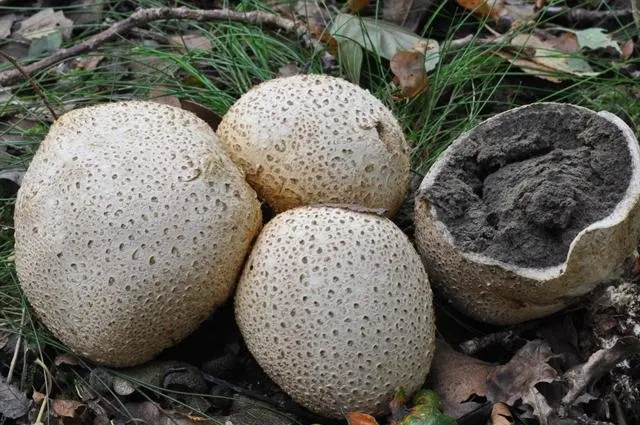Common puffball (Scleroderma citrinum)
- Division: Basidiomycota (Basidiomycetes)
- Subdivision: Agaricomycotina (Agaricomycetes)
- Class: Agaricomycetes (Agaricomycetes)
- Subclass: Agaricomycetidae (Agaricomycetes)
- Order: Boletales (Boletales)
- Family: Sclerodermataceae
- Genus: Scleroderma (False raincoat)
- Type: Scleroderma citrinum (Common puffball)
- Raincoat false
- False raincoat orange
- Puffball lemon
- Puffball lemon
- Scleroderma citrinum
- Scleroderma aurantium

fruiting body: Fruit body up to 6 cm in ∅, with a smooth or finely scaly shell of a dirty yellow or brownish color. In the upper yellowish or ocher surface, when cracked, thick warts are formed. The lower part of the fruiting body is wrinkled and bare, slightly narrowed, with a bundle of root-shaped mycelial fibers. The shell (peridium) is rather thick (2-4 mm). In old age, the gleba turns into an olive-brown spore powder, and the shell at the top is torn into sections of different sizes.
inner pulp (gleba) of the fruiting body is white when young. At maturity, pierced with white sterile fibers, then, the smell resembles the smell of raw potatoes. Spores are spherical, reticulate-warty, dark brown.
Disputes: 7-15 µm, spherical, with spikes on the surface and reticulate ornamentation, black-brown.
Growth:
The common raincoat grows in deciduous and coniferous forests, along roads, along the edges, on clay and loamy soil in August – September.
Use:
Common Puffball – Inedible, but only in large doses. If you mix 2-3 slices with other mushrooms – harmless. It is sometimes added to food because it tastes and smells like truffles.
Video about the fungus Common puffball:









